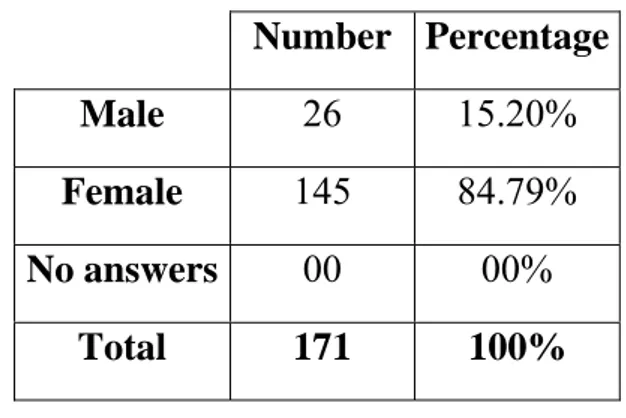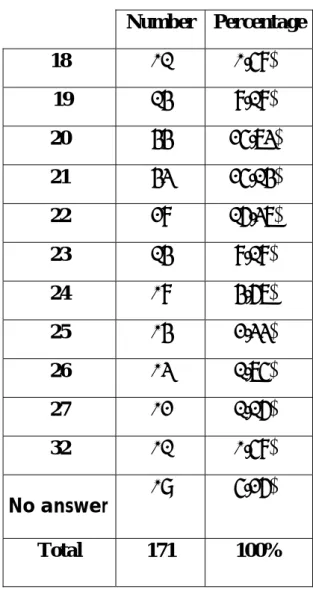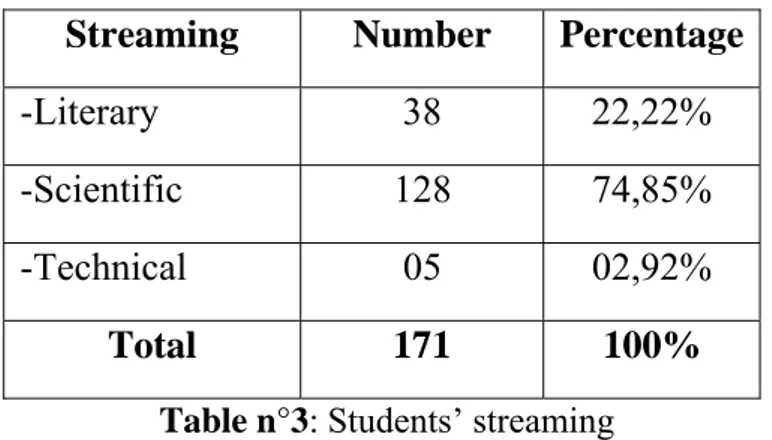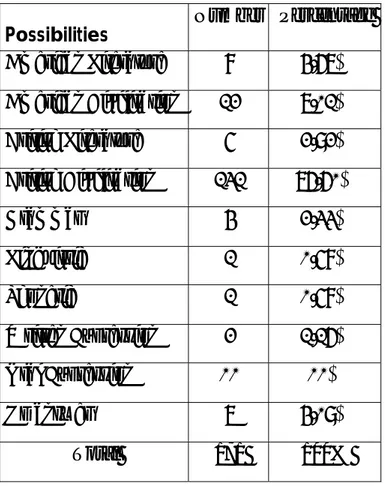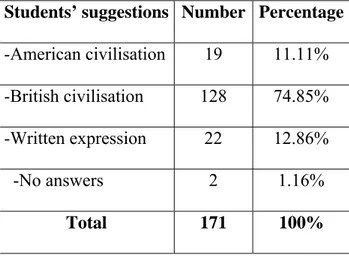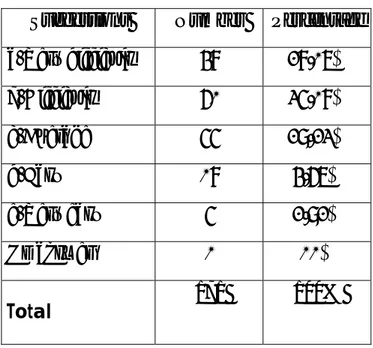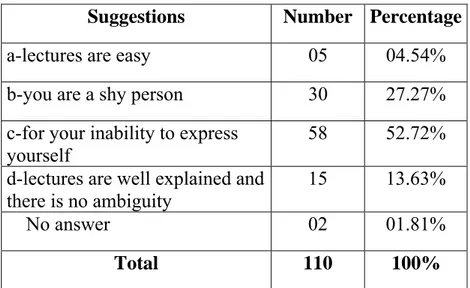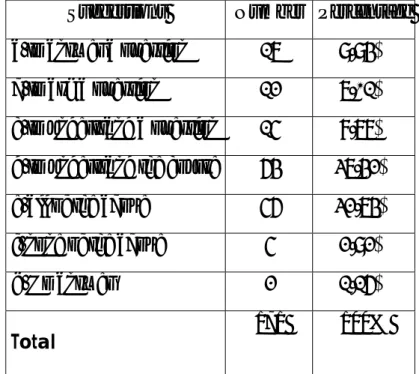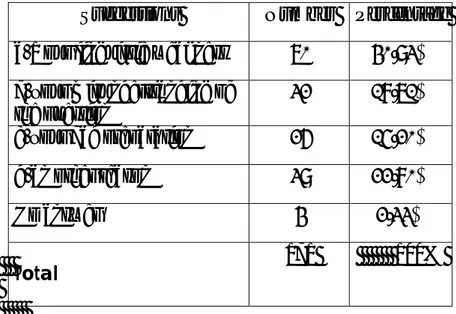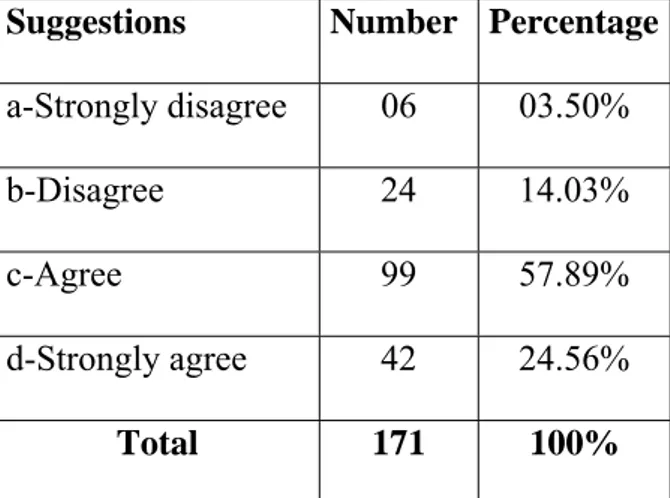Hadj Lakhdhar University -Batna- Faculty of Letters and Human Sciences
Department of English
English Language Proficiency as a Prerequisite to Study
British Civilisation by Second Year Students of English
at Batna University
Dissertation submitted in partial fulfilment of the requirements for
magister degree in language and communicative competence
Presented by: Supervisor:
Miss Aïda Abdessemed
Dr.O.Ghouar Board of Examiners:- Chairperson: Pr.Mohamed .S Nedjaï - University of Batna - - Supervisor: Dr.O.Ghouar - University of Batna - - Member: Dr. Derbouche -University of Khanchla -
To my family
For you Mum
I dedicate it also to
You Dad
Hasna,Ibtissem,and Amani DEDICATION
Acknowledgements
First of all , I would like to thank Dr. Ghouar for accepting to supervise my humble work and for his relevant advices and guidance.
My sincere and deepest gratitude go to Dr. S. Abdelhamid to whom I’m much indepted .
A special consideration goes to Mr. Ch. Gasmi for his incessant infinite care, support and encouragement.
Last but not least, I wish to thank all teachers of the Department of English namely, teachers of British civilisation, Pr. Nadjai, Dr. Khiredine, and Mr. Bouteraa . Without forgetting all second year students (2004-2005), Mrs. K. Houwara for her unconditional help and all my friends.
Abstract
The present study aims at identifying the effect of students’ English language proficiency on communicative modes, both receptive and productive ones, in as far as the module of second year British civilisation is taught in the department of English at Batna University. Along a descriptive study, the attempt was to highlight the nature of the relation existing between students’ English language proficiency and their achievement in this module. Questionnaires’ use on the population of both students enrolled for the academic year 2004-2005, and teachers of the module, revealed not only the tie aspect of this relation, a fact latterly confirmed through the analyses of second term students’ exam copies; but furthermore evoked its significant impact on students’ affective side like apprehension, involvement and motivation to study the module. On the basis of literature reading and field work results, some recommendations have been drawn, in order to attract both teachers’ and students’ attention on the role the language proficiency performs at the level of their understanding and language development, which is later on reflected on their achievement.
List of Abbreviation C1: First culture C2 : Second culture CF: Foreign culture DM: Direct Method FL: Foreign language GT: Grammar Translation L2: Second language
RAM: Reading Approach Method SL: Second language
T C: Target culture
List of figures
Figure n° 1: Complex links between language and culture:
a framework of communication and learning………52 c
ohm
List of tables
The students’ questionnaire result analysis tables
Table Page
Table n° 1: Students’ gender...65
Table n° 2: Students’ age………...65
Table n°3: Students’ streaming……….66
Table n°4: Students’ personal evaluation of their linguistic competence……...66
Table n°5: The most difficult module according to second year students in respect to their language competence………...67
Table n °6: The module that requires a more important linguistic proficiency... 68
Table n°7: Students’ interest to the module of British civilisation... 69
Table n°8: Students’ justifications of the British civilisation appreciation……..70
Table n°9 : Students’ evaluation of British civilisation course accessibility...….71
Table n°10: Students’ perception of the linguistic competence importance in British civilisation………...71
Table n°11: Students’ understanding during lectures of British civilisation…...72
Table n°12 :Students’ asking questions in lectures of British civilisation…..72
Table n°13: Subject of students’ questions……….73
Table n°14: : Causes of students’ refusal to ask questions………...73
Table n°15: Students’ evaluation of British civilisation’s teachers’ questions...74
Table n°16: Students’ most difficult activity to do in British civilisation lectures…….75
Table n°17: Students’ most difficult thing met during exams………..75
Table n°18: Students’ most difficult thing met during exams ………... .76
Table n° 19: Students’ preference of language use………...77
Table n°20 : Students’ evaluation of British civilisation linguistic requirements…77 Table n°21: Students’ evaluation of the difficulty of British civilisation vocabulary……….78
Table n°22: Students’ evaluation of their fulfilment in second year British civilisation module……….78
Table n°23: Second year as the most appropriate to study British civilisation….79
Table n°25: Students’ suggestions to ameliorate the studying of
British civilisation……….. 80
The teachers’ questionnaire result analysis tables Table Page Table n°01 :Teachers’ evaluation of students’ language proficiency………… .86
Table n°02: Teachers’ evaluation of students’ language proficiency importance i in British civilisation………...………...86
Table n°3: Degree of language importance according to teachers………...87
Table n °4:Teachers’ arguments for students’ language proficiency Table n°5: Teachers way of presenting British civilisation lectures………88
Table n°6: Teachers’ explanations………...88
Table n°7: Teachers evaluation of students understanding………..89
89 Table n°8 : Identifying students’ linguistic competence as the origin of their n understanding problem…………...89
Table n°9: Teachers’ evaluation of students’ classroom interaction …… …….90
Table n°10: Teachers evaluation of students difficulties……….90
Table n°11: Teachers’ evaluation of students’ errors kind ………... 91
Table n°12: Teachers’ evaluations of students’ questions kinds……… .91
Table n°13: Students’ request for translation………...92
Table n 14°: Frequency of teachers’ use of translation………..92
Table n°15: Teachers’ explanation about students’ need of translation……….. 92
Table n°16 : Students’ difficulties during exams ………93
Table n°17: Teachers manner/way of correction ………93
Table n°18: Teachers’ justification about their exam copies correction ………94
Table n° 19 :Linguistic wealth of British civilisation module ………94
Table n°20 :Language difficulty of British civilisation module………. 95
Table n°21: Teachers’ evaluation of the fulfilment of the module of British Civilisation………...96
Table n°22: Teachers’ attitudes toward delaying British civilisation module….97 Table n°23: Teachers’ suggestions for an easier learning of British civilisation.97 Students’ exam copies analyses’ table Table n°1:Second term exam copies’ analyses of second year students in the module of British civilisation ………102
Glossary
Appropriateness: The particular item to put in the appropriate context .A word may be common, rare or taboo.
Audio lingual method ( Listen and speak): this method considers listening and speaking the first tasks in language learning, followed by reading and writing. There is considerable emphasis on learning sentence patterns, memorization of dialogues and extensive use of drills Communicative competence :The ability to use the language effectively for communication.
Competence: Defined by Chomsky as ‘the speaker-hearer’s knowledge of his language’. Connotation: The associations, positive or negative feeling that an item may evoke ex: Flower.
Denotation: The meaning of a word in the real world.
Direct Method: The most common approach in TEFL, where language is taught through listening and speaking. There may be little or no explicit explanation dealing with syntax or grammatical rules, nor translation into the mother tongue of the student - inductive learning rather than deductive.
Grammatical competence: Attributed to Chomsky, is the speaker’s knowledge of the grammar rules which govern the language.
Grammar Translation: A method based upon memorizing the rules and logic of a language and the practice of translation. Traditionally the means by which Latin and Greek have been taught.
Interference: According to behaviourist learning theory, the patterns of the learner's mother tongue (L1) get in the way of learning the patterns of the L2. This is referred to as 'interference
Linguistic competence: A broad term used to describe the totality of a given individual's language ability.
Over-generalization: Language learners often produce errors which are extensions of general rules to items not covered by the rules. For example, 'I comed home'. This is called ‘over-generalization’.
Performance: The actual use of language in a concrete situation.
language is first, reading ability and current or historical knowledge of the country where the target language is spoken.
Receptive Knowledge: means being able to recognize one of the aspects of knowledge through reading and listening.
Transfer : Knowledge of the L1 is used to help in learning the L2. Transfer can be positive, when the two language have similar structures, or it can be negative, when the two languages are different, and L1-induced errors occur
Dedication...I Acknowledgements... II Abstract... III List of abreviations... .IV List of figures...V
List of tables...VI Glossary... ..VII
Introductory Chapter
Introduction...1
1. Background and significance of the study………2
2.Statement of the problem ………..3
3.The hypothesis...3
4.Basic assumption...4
5.Objectives of the study ...4
6.Definition of terms...4
7.Limitations of the study...5
8.Methodology design...5
9.Data collecting tools...7
10.Data analyses...8
Part A: Literature Review Chapter one: Culture Teaching Introduction...9
I.1.Culture versus Civilisation Terms Use...10
I.2.Definition of Culture...11
I.3. Definition of Culture in the Language Classroom...13
I.3.1. Culture in Anthropology...13
I.3.2. Culture as Perceived by Teachers...17
I.4. Language and culture...19
I.5.The Historical Background of Culture and Language Teaching...23
I.6.Teaching /Learning Culture in FL/SL Classroom...29
I.7. Importance of Language Culture Teaching/Learning...33
I.7.1.The Importance of Culture in Communication...37
I.8.The aim of culture teaching/learning...38
I.9.To What Extent Culture Should be Taught/Learned?...39
Conclusion...42
Chapter Two: English Language Culture Teaching Implication Introduction ...43
II.1.English Language Teaching in Algeria and its Effect on learners’ Language Proficiency...44
L II.2.English Language Culture Teaching in Algeria...47
II.3.What is British Civilisation Module ?...48
II II.4.Problems of Teaching Culture...49
II.4.1.Problems Encountered When Teaching Culture...50
II.4.1.1.The Culture to Learn Culture...50
II.4.1.2.The Culture to Teach Culture...52
II.4.2.2. Psychological Problems...59
II.4.2.2.a.Acculturation...60
II.4.2.2.b. Misunderstanding...61
II.4.2.2.c.Cultural shock...61
II.4.2.2.d.Stereotyping...62
II.5.Language Teachers’ Role to Solve Learners’ Psychological Problems...62
II.6.Language Proficiency and Linguistic Competence...63
II.7.Vocabulary in Language Proficiency and its Effect on Learning Process……….65
II.8.Aspects of Meaning Needed in Language Comprehension and Production...66
Conclusion... 68
Part B:Field Work Chapter Three: Students’ questionnaires Introduction...69
III.1.Description of students’ questionnaire...69
III.2.Administration of students’ questionnaire...70
III.3.Data Analysis...…....72
III.4.Findings...90
Conclusion……… .92
Chapter Four:Teachers’ questionnaire Introduction...93
IV.1.Administration of the questionnaire...……... .93
IV.2.Description of teachers’ questionnaire……...93
IV.3.Presentation of data……….94
IV.4.Data Analyses ...……...95
IV.5.Findings………..………...108
Conclusion………...………...109
Chapter Five: Students’ Exam Copies Analyses Introduction………...………..110
V.1.Description of exams’ questions...111
V.2.Students’copies sampling procedure ... 112
V.3.Data treatement………113 V.4.Findings...119 Conclusion………...124 Recommendations...125 General Conclusion...127 Bibliography...128 Appendices...131
Introductory
Chapter
Introduction ………1
Background and Significance of the Study……....2
Statement of the Problem………..…………..3
The Hypothesis………3
Basic Assumption………4
Objectives of the Study………4
Definition of Terms……….4
Limitations of the Study………. 5
Methodology Design……… 5
Data Collecting Tools………..7
Introduction
English language teaching / learning has increasingly gained a relevant portion in the educational systems all over the world during the last decades. The met challenge, however, arises from the question how to teach the foreign language with its relative culture. An unavoidable step, mainly considering the claims stressing the tie relation connecting both : the foreign language and its culture. Stemming not only as the natural environment of the language, culture performs an important role as an enhancer of the former. Hence, to speak correctly the foreign language, the foreign language learner, has firstly to know about this culture. Once dealing with real classroom situation, the concern is no more to tackle the issue of culture teaching/ learning importance, which becomes an evidence, and /or to evaluate the variant aspects may be generated from its inclusion, but rather to concentrate much efforts to set the question of how to introduce it. Mainly in regard of the required tool to transfer the cultural information, which is the foreign language. Not adequately mastered yet, the language, would represent a new impediment to the foreign language learner, who would face not only a set of information he is not familiar with, but has to process them using a language he handles to a very limited extent. The case of second year students in the department of English at Batna University, who not accustomed to deal with “content courses” like British civilisation, seem meeting difficulties to use their English language proficiency, the unique mediator between them and the cultural information this course presents to them. In the two first chapters constituting the literature review, the interest was firstly to shed the light on the historical background of culture inclusion in the foreign language classroom, and then to denote its aim and importance in the improvement and development of learners’ language proficiency. Secondly, to highlight culture teaching basic requirements as far as problems mainly related to foreign learners’ English language proficiency in general, and with reference to the Algerian context in particular.
1. Background and Significance of the Study
Foreign language teaching is foreign culture teaching as maintained by many educators “by teaching language...one is inevitably already teaching culture ...” (McLeod, 1976:212, cited in Thanassoulas, 2001:6) .Thus, whatever the aspect under which it is introduced in the language classroom, either implicit or explicit, culture teaching remains an important ingredient of foreign language learning.
To study the foreign culture, implies dealing with messages specific to the foreign language community, through, the use of the foreign language, which is the vehicle to transmit the cultural information. Any deficiency in the language ability of the learner, immediately interferes in the quality of the message which they are expected to receive and later on to convey, so they will deal with either “meaningless symbols or symbols to which they attach wrong meanings ” Politzer (1959:100-101, Ibid:3).
This is what we personally experienced as a second year student, during our learning stage, and what we noticed again, but as a teacher of the module of British civilisation in the department of English at Batna University. In both experiences, second year students expressed an incomparable difficulty in the module of second year British civilisation, either if compared to other modules in the same year or with the same module in the other stages -third and/or forth years- . Many elements may be at the origin of learners’ difficulty: the content, the teacher, the method, the newness of the module and so on. Yet, only one factor corresponds to the kind of obstacles students frequently refer to, and which are reflected in the kind of questions our classmates, during our studying stage, as well as our students in the module of British civilisation, ask and which are related to the communication of meanings of words rather than the content itself. Consequently, students are mislead by wrongly interpreting events. A fact clearly depicted in their performances mainly in the provided answers during official tests and examinations.
Therefore, we have decided to conduct this research to examine to what extent students’ English language proficiency permits a successful teaching / learning of second year British civilisation.
2. Statement of the Problem
British civilisation module is one of the content courses or as pointed at by Littelwood (1981:46) courses having a “dual role”, since it offers the possibility to learn the foreign language by the same time to learn through it. Its main concern is to introduce the foreign language learners, in our case English language learners, to the target community by tackling different cultural aspects. Introduced in the curriculum starting from second year at English department, students at this stage seem encountering many difficulties in this module. Difficulties related not only to their unfamiliarity with the module but mainly with their English language proficiency which is at this particular stage not sufficiently developed yet to meet their needs, either in terms of receptive requirements or for the productive ones. Consequently, it impedes not only their understanding and absorption of the cultural information, but exceeds to work out their predisposition and involvement to study the module. The fact that pushed us to look for the issue so to attract teachers’ attention on the seriousness of this problem generally not attributed due importance if compared to other elements like the content for instance.
3. The Hypothesis
We hypothesise that second year students’ poor English language proficiency negatively affects their achievement in British civilisation module. Being the tool mediating the learner and the cultural information, its quality stands as an obstacle to the module set objective.
4. Basic Assumption
We assume that second year students of English are not adequately prepared in terms of English language proficiency to deal with British civilisation course.
5. Objectives of the Study
The main objectives of the present study are:
1- To investigate the relationship between second year students’ English language proficiency and their achievement in the module of British civilisation.
2- To analyze language proficiency’s importance on both: students' receptive and productive competences in the module of British civilisation.
3- To know if second year students possess the sufficient language proficiency required to deal with British civilisation module or not.
6. Definition of Terms Language proficiency:
-The possession of the fundamental linguistic information derived from enough practice and experience to be able to understand and use language.
- The linguistic competence necessary to performance. (Cambridge Dictionary of American English, 2004)
Prerequisite
A previously required, necessary as preliminary to any proposed effect or end ; as, prerequisite conditions of success.
7. Limitation of the Study
Along this study, we will be limited to the analyses of second year students’ English language proficiency role on their achievement in the module of British civilisation. Focus will be made on isolating the linguistic element without attributing much concern to other involved factors in the learning process like motivation or the teaching method for instance. This limitation is explained in terms of students’ complaints and questions, mainly connected to the expression of meaning of the language .A phenomenon less apparent in other modules of the same year(2nd) or in the same module
in other years(3rd & 4th ).The fact that explains in its turn the choice of the second year
level.
The choice of the course of second year British civilisation, is based on a host of facts, first of all: The nature of the course language requirements in terms of accuracy/fluency. Secondly, it is newly introduced to students in this year (second year) who, and most importantly, come from different streams which implies many differences, that first year is supposed to erase linguistically speaking. Furthermore, in relation to the kind of vocabulary this course presents students with, which differs of vocabulary used in the courses of phonetics for instance, which is rather terminological, or the one of literature courses, which is artistic. Thus, by doing so we reduce the probability of vocabulary difficulty.
8. Methodology Design
a- Choice of the Method
In order to draw the link between second year students’ language proficiency and their achievement in the module of British civilisation, we opted for the use of the descriptive method ,which will permit us to identify this relation and moreover to collect the needed data about the subject under investigation. An experimental study would be of no usefulness if we consider that nothing new would be tested and that we will only report and analyse conditions of the current situation and thereby to clarify its status. The
research findings may provide with a theoretical framework for future research that may opt for other methods use like the experimental one.
b- Population
Both students’ and teachers’, of the department of English at Batna University, attitudes toward the subject under investigation are of relevance in this study, that is why we will deal with both populations:
Students concerned by our research are second year students of English at Batna University enrolled for the academic year 2004-2005. Their exact number is 349 students divided out to 7 groups (information obtained from the administration).
The choice of these subjects is related to a number of facts, namely in relation to the module of British civilisation which is newly introduced to them in the second year . Secondly, in relation to their linguistic background, if we consider that they come from distinct streams, with different linguistic abilities that first year is expected to erase. More importantly, this choice is based upon learners’ complaints noticed along our studying and teaching experiences.
The teachers concerned in our study are : those who had already taught second year British civilisation and those who actually still teach it at Batna University. In regard of their small number (seven), sampling will be of no need. Since what we point at, is the teachers’ perception of the problem under investigation .The most important stressed criteria of this population’s selection is the teaching of second year British civilisation.
Students’ Sample
Since the objective of the study is to get all students’ perceptions of the problem, so the questionnaire will be administered to the whole population of second year.
A stratified sample will be needed later on to select students’ exam copies. The choice of this particular kind of sampling is explained in terms of the possibility it offers
to minimize the chance that our sample group will include a disproportionate number of students representing a particular subgroup like in our case, where the attributed grades in the module of British civilisation is the criteria according to which we represent the whole population . Therefore, second year students’ second term exam copies will be divided into three groups. Each group contains the similar grades, low- average -good. From each group the same number of copies will be randomly selected by keeping the same gender representation of the whole population.
9.Data Collecting Tools
In order to bring more consistency to the study, we opted for a combination of two tools, so that each instrument is designed to test the validity of the other as following:
Questionnaires : In order to obtain the perception of the students and the teachers, a questionnaire is designed for both populations, with little difference in terms of vocabulary (students questionnaire uses a very simple vocabulary) . The questionnaire is used as the main source of data and seems the most appropriate tool for many considerations like: the large number of the population under study, its guarantee of the respondents’ anonymity, and the short period of time if compared to the interview for instance. The questionnaire will be directly administered to the teachers and the students of the department of English at Batna University by the end of the academic year 2004-2005, which corresponds to the period (six months studying) of students' familiarity with the module.
Second year students' exam copies: In order to consolidate data obtained from students’ / teachers’ questionnaire , we will use second year second term students’ exam copies in order:
-to measure their capacities to understand questions addressed to them, hence to test their perceptive abilities; and
- the way they use their language proficiency, so to check kinds of errors they make which represents their productive abilities.
The choice of the second term examination instead of the first one, is to reduce the effect of students’ unfamiliarity with the module, which may affect in its turn their achievement.
Piloting
Piloting the questionnaire was of a great relevance since it permitted us to bring important corrections namely in students’ questionnaire. By piloting it on a randomly selected population of 35 second year students, all of them expressed a difficulty in understanding some utterances like proficiency, and achievement that have been all substituted in this order by competence and performance.
10. Data analyses
All the obtained data will be presented in tables. Statistically analysed to be interpreted . Answers are going to be represented in terms of numbers and percentages .
CHAPTER ONE
Culture Teaching
Introduction………9 I.1.Culture versus Civilisation Terms Use……….10 I.2.Definition of Culture………11 I.3.Definition of Culture in the Language Classroom………...13 I.3.1.Culture in Anthroppology……….13 I.3.2.Culture as Percieved by Teachers………...17 I.4.Language and Culture………..19 I.5.The Historical Background of Culture and Language Teaching…………..23 I.6.Teaching/Learning Culture in FL/SL Classroom……….29 I.7.Importance of Language Culture Teaching /Learning……….33 I.7.1.Importance of Culture in Communication……….37 I.8.The Aim of Culture Teaching /Learning………..38 I.9.To What Extent Culture Should be Taught/Learned………39 Conclusion ……….42
Introduction
During the last decades, the English language has been firmly established as the uncontested international language all over the world. As a result, a great interest in teaching/learning it is increasingly raising.
Being not neutral, by teaching the language one is already transmitting its culture as well, since beliefs, values and thoughts are all inherent in the linguistic code itself. A fact that pushed educators to reconsider the status of culture in the language classroom so to be recognized later on in the foreign language pedagogy as an integral constituent of the language instruction.
In this chapter, we tend to probe the coming together of the English language to be taught and its relative culture, its role and importance in students’ language development.
I.1. Culture versus Civilisation terms use
Compared to the word ‘culture’, the French term ‘civilisation’ is recent since it appeared in the late 18th century. It is inspired from the words ‘civilisé’ and ‘civiliser’ that had already existed in the 14th century as mentioned by F. Braudel (1987:33). Moreover; both terms had been quickly adopted by the Europeans, in England by 1772, as well as in many other Anglo-Saxon countries however civilisation largely dominated the word culture to the extent that “ ... culture for a long time is considered as the synonym of civilisation” (1) (personal translation from
Ibid.35). Through centuries, both terms have been used interchangeably in a way that frontiers limiting their use and meaning are becoming unclear and unset mainly when it concerns the field of language classroom as notified by A.G.Radenkovic (2004:47)
Equivalence between both terms “civilisation” and “culture” appears commonly admitted in languages’ didactics [...] it even seems that both terms had been used in an indifferent manner
in the language classroom... (2)
(personal translation) In the language didactic dictionary, Gaisson and Cost (1976, ibid: 106)
confirmed the same fact, stating that culture is defined as a synonym of civilisation having an equal significance, components, dimensions, and traits, that may be explained in regard to the historical background of their indeffrenciated use.
This interchange ability in use of both terms is not restricted to the language classroom but expanded to different countries all over the world. So what is meant in English culture is named in French civilisation as stated by Kramsch (2004:8) culture“... is called (Fr.) civilisation, (G.) Landeskunde, or (Eng.) culture”.
1) « longtemps culture ne sera que le doublet de civilisation »
2) « L’équivalence entre les termes ‘’civilisation” et “culture” parait communément admise dans la didactique des langues [...] il semblerait même que les deux termes aient été utilisés de manière indifférenciée dans la classe de langue… »
Being not a member of the French-speaking countries, however Algeria is highly influenced by the French language, so that culture is referred to civilisation.
Respectively, we wish to inform the reader that what lies behind the teaching of British civilisation in our study, is what is agreed on in many other Anglo-Saxon countries British culture teaching.
I.2.Definition of Culture
To the question “what is culture?”, one will meet many difficulties to give a particular answer as Nemni (1992) and Street (1993) declared “This is not an easy question to answer, particularly in an increasingly international world”(cited in Clouston, 1997: 3) . The reason simply resides in two facts. Firstly, culture for a long time had been the central concern of a large category of researchers from linguists, ethnographers, scholars, anthropologists, to educators, and social scientists. Each one defines it according to his field and discipline, which resulted in an infinite and unlimited number of interpretations that reflect different theories for understanding and valuing human activities. This variety allowed Krober and Kluckhohn (1954:3) to find over three hundred definitions in their study mainly when it comes to its relation with language.
Secondly, and besides considering culture as a “broad concept” (Seelye 1984, cited in Hall 2001:1)“complex”(Clouston,1997:4), and “that needs to be handled carefully” (Kerr,2004:1). There is an other relevant element, that contributes largely in the almost impossibility of obtaining a unique definition of culture, which is its “dynamic nature” ( Thanassoulas, 2001:8) and its permanent change in relation to who perceives it and when it is perceived as brilliantly advocated by Harklaw (1999,cited
in Hall 2001:4)“Culture is an elusive construct that shifts constantly over time and according to who is perceiving and interpreting it.”
Though the myriad of definitions attributed to the word culture, and differences in the description of its nature, its variant traits and dimensions, so that it can be an ideology, a philosophy, a belief, a product, a practice or an action, etc. It can be learned, acquired, created, shared, passed, inherited or transmitted; all the researchers ,admit its humanistic aspect assuming that culture is‘ man made’ (Taibi, 2002: 20).
Similarly, the transmissible aspect of culture reveals that it may be passed through language, which reflects in fact the kind of relation between the two: language and culture. Kramsch (2004:1) advocates this relation and stresses the fact that “One of the major ways in which culture manifests itself is through language. It is because of that mediatory role of language that culture becomes the concern of the language teacher ...”. She also adds to that:
... culture is often seen as mere information conveyed by the language, not as a feature of language itself, [...].If, however, language is seen as a social practice; culture becomes the very core of language teaching ... (Ibid. p8) A position shared also by the linguists Peterson and Coltrane (2003:1) “ ... language is not only part of how we define culture, it also reflects culture”.
On the light of this privileged relation, focus will be made on defining culture as perceived in the language classroom.
I.3. Definition of Culture in the Language Classroom
The number of ways culture is defined does not prevent educators to have a precise view when it comes to its relation with language .Valette (1986) explains it as follows:
There are two ‘major components’ of culture in the language
classroom.' One is the anthropological or sociological culture .... The other is the ‘history of civilization’ which traditionally
represents the cultural element in foreign language teaching, it includes geography, history and achievements in the sciences,
the social sciences and the arts. (p. 179) Accordingly, we will define language culture in respect to both
anthropologists’ and teachers' point of views.
I.3.1. Culture in Anthropology
Culture has been defined in a number of ways, as noted by Useem, J, & Useem, R (1963:169 cited in Hall, 2001:6) especially by anthropologists. This abundance covered the concept only on its general aspect and from a global view what makes the difference with the teachers’ definition.
For instance, Lado (1957,cited in Cloustan,1997:3) and Trivedi (1978:93 cited in Taibi,2001:21), both define culture as “The ways of a people”. What Brooks (1960,cited in Thanassoulas,2001:5) on his part names ‘The modus-vivendi’. Carlyle and Coleridge however, (cited in Williams,1963:124-125,cited in Paulverness,2002:3) align themselves with Montgomery and Reid-Thomas (1994:5 cited in Thanassoulas,2001:9) and adjust slightly the meaning by adding two words to the former expression. Thus, the result is “It is the whole way of life for a people or a group”.Kallenbach & Hadges (1963:11,ibid) changed only the structure of the same expression that resulted in the following “The total life way of people”.
Williams (1965:3,cited in Byram,1989,cited in Taïbi,2002:21)on the other hand by defining culture, distinguished between three of its aspects .He names the first ‘the ideal’ which reflects according to him 'certain universal values' common to all humans. The ‘documentary’ concerns the recordings of all human intellectual works. Whereas the 'social' type and last one consists of meanings and values that one may extricate from all man’s productions and achievements. Furthermore, and beside this evident agreement concerning the meaning of ‘culture’, a number of anthropologists agreed on three of its traits:
Social scientists and especially anthropologists have been
redefining the concept culture . Although one can find a variety of definitions , many anthropologists have agreed
on three basic traits that are common to all . These traits are: culture is shared, cultural components are interrelated
and culture is learned. (Hall, 2001, p.13)
To understand these traits it is easier to go back to the definition of culture itself and to deal with each one solely for their importance.
For instance, since culture has been ranged in the category of all what is ‘man made' as mentioned earlier, and encloses all features of humans' lives .So it goes without saying that it takes its roots inside of a community whose members accept and agree on its different and variant features as claimed by Birslin (1990, cited in Kramsch, 1993:11)
Culture refers to widely shared ideals, value formation, and uses categories assumptions about life and goal- directed activities that become unconsciously or subconsciously accepted as “right” and “correct” by people who identify themselves as members of a society’
This reflects a logical interaction and exchange that take place as a natural social practice which clearly explains the notion of “sharing” as asserted by many anthropologists like Hall(2001:38) and Seelye (1984) to whom culture “embraces all aspects of shared life in a community». Ruth-Benedict (p.46, cited in Peck, 1984:1), Montgomery and Reid-Thomas (1994:5,cited in Thanassoulas,2001:9) all qualify culture as what “binds people /or a group of people together”. To that and with more force, Brown(1994:3,cited in Hall,2001:2) refers to culture as the “glue” connecting people together.Goodenough (1964:36, cited in Byram, 1989,cited in Taibi,2002:22)specifies that sharing any cultural aspect is closely connected to a mutual exchange of respect among all members of a community so that to be themselves accepted in it.
If comparing both traits sharing and learning of culture, difference will be clearly notified in the direction that culture undertakes to pass within members of a community. When sharing is meant its spread among individuals of the same generation, by learning culture, anthropologists point its travelling through time. Hence its transmission from one generation to an other within the same social group, as stated by Duranti “Culture is something learned, transmitted, passed down from one generation to the next, through human action, often in the form of face – to face interaction, and of course through linguistic communication.” (1997:24,cited in Thanassoulas, 2001:8). Because of its transmission, many consider culture as a heritage like Bowers who designates it as “An inherited wealth...passed on to us from different sources.”(1992:31cited in Taibi, 2002:22).
In many other definitions the term ‘learned’ had been substituted by ‘acquiring' like in Kalbenbach and Hodges (1963:11 cited in Thanassoulas,2001:10)one. They confirm that “It is the social legacy the individual acquires from his group”. Yule
(1985:246) also used the term ‘acquired’ when defining culture as ‘a socially acquired knowledge’.
What is worthwhile to mention, however, is that culture’s transmission, though is carried out through a myriad of ways, but can not be conveyed via genes as stressed by Hofstede (1984:8)
Culture ...consists in those patterns relative to behaviour and the products of human action which may be inherited that is, passed on from generation to generation independently of the biological genes.
Evidence in both traits’ definitions, and their attributed chronological order, it is clear that people first share and then learn as in Bodley’s definition “shared, learned, symbolic, transmitted from generation to generation” (1994:36). Admittedly, that learning is limited in its meaning to the transmission of culture from one generation to an other, this does not prevent two members belonging to the same generation to learn from one another and thus, sharing their cultural knowledge as maintained by Peck (1984:1), and supported by Useem, J S.Useem, R (1963:169, cited in Hall,2001:14), who all specify that culture “is that facet of human life learned by people as a result of belonging to the same particular group, it is that part of learned behaviour shared with others”. Seen from this perspective, people learn first the culture to share it latter on with others, as being a common possession to the whole community.
When the two first (learning and sharing) deal with the way culture is spread out, the third trait however, treats the essence of culture itself, its different constituents and the relation binding them together. Anthropologists attempted, each and from different stand points, to assemble as much elements as possible, that suit their perceptions. By including distinct constituents, that may vary from rudimentary, humans' needs and different aspects of their daily lives like ‘the table manners’,
according to Chritophersen (1973:32 cited in Taibi, 2002:21), “diet, costume, language” according to Jaramillo (1973:51.Ibid.p22) going to Kallenbach&Hodges(1963:20,cited in Thanassoulas,2001:8) more complex aspects covering ‘the biological processes’ such as vomiting, weeping, fainting, sneezing and other sensations of pleasure, hanger and lust, which effectively and harmoniously fits the definition of culture as " the whole" and which expands its connotation to cover larger horizons of humans’ life, and so elevates to reach the higher arts and superior needs, as mentioned by Saville-Troike (1975:83) “the whole material manefestations’ that are easily seen and that means the physical and concrete aspects and ‘the non material-one’ ” which embraces the abstract prospect such the religion, beliefs, morals, values, skills and all the like.
I.3.2. Culture as Perceived by Teachers
On a more specific level, educators opted for defining culture in respect to two distinct aspects but with a great relevance in teaching .Though the diversified manners of naming both, they all converge in the same sense. Whether, it is pointed out the formal/ deep culture by Brooks (cited in Peck 1984:2), the high/ low culture by Singhal(1998:3), the achievement/behaviour culture of Tomalin & Stempleski (1993, cited in Pulverness, 2003:2) or the MLA/BBV for Hall (2001:1);all refer to what is agreed on the ‘capital C culture’ (the Olympic or “Big –c” ) and ‘small c culture’ (the Hearthstone or “little –c”) (Ibid) .Both are prominent in the foreign language classroom.
When the capital C culture, reflects the ‘humanities’ Kramsch(1994:8) and all the material productions like architecture, technology and even politics, including Brooks’s MLA, which are Music, Literature and Arts .The ‘small c culture’ however,
concerns the other facet of humans’ lifestyles and every day occupations that Brooks again, qualifies as BBV Beliefs ,Behaviour and Values, that represent for him every thing in human life. Which signifies for Nostrand “the ground of meaning”(1989:51 cited in Kramsh,1994 :1).
For a further precision, Adaskou, Britten and Fahsi (1990:3-4,cited in Clouston, 1997:4) suggest an other classification that comprises four ‘senses’, including the ‘capital C and small c cultures’, but with a slight difference in nomination. In that, the first is referred to as the ‘aesthetic sense’, and by which people “tend to develop the highest faculties, the imagination, the sense of beauty and intellectual comprehension” according to Rivers (1969:263,cited in Syed,1988:45,cited in Taibi,2002:23). Whereas Hall(2001:3) qualifies it as the ‘best in human life’, and moreover precises that it is restricted to the elitists .The ‘sociological sense’ which equals the “small c” culture refers to family organisation and nature such customs, interpersonal relation , institutions and all what a society is built on.
In respect to teaching, these two types are intended ,each a part, for a specific learning stage as outlined by Taibi (2002:23) .That is the ‘small c culture’ is ‘much suitable for beginners and intermediate foreign /second language learners, while the ‘capital C culture’ would suit advanced learners “who wish to explore the society’s contributions to the world knowledge and civilisation in greater depth and breadth” (Chastain, op.cit.388; Ibid).
‘The semantic’ and third sense on the other hand, encompasses the whole conceptualization system which conditions perceptions and thought processes(Adaskow.et. al .op.cit2).
The last sense is the ‘pragmatic or socio-linguistic one’ that involves all the linguistic and non-linguistic symbols, features, and skills; the background knowledge necessary for successful communication.
At any rate, and to conclude what had been said about culture, though the myriad of definitions attributed to the term , either by teachers or anthropologists, culture resides in the fabric of human's lives and regulate them at any turn .What is more important now is to identify what the relation binding language and culture is about.
I.4. Language and culture
No one would deny the existence of a strong connection between language and culture that had been and for a long stressed by many scholars mainly when it concerns language teaching/learning. This relation was too far emphasized, so that very powerful terms had been used to designate it and to depict each of its patterns. Researchers, each in his way and according to his domain tempted to come as nearly and closely as possible to the reality of describing it to the best.
Alptekin (1993:136,cited in Taibi,2002:20), claims that “language and culture are inextricably tied”. Malinowski (1923) also maintains that “language is essentially rooted in the reality of the culture” . Even the famous linguist Edward Sapir, who in the 1920’s (cited in Hinkel,1999:2) stated that ‘‘language and the culture of its speakers cannot be analyzed in isolation’’, sooner contradicted his first statement by 1921 and firmly claimed, that “language, race and culture are not necessarily correlated ” (1921:215,cited in Thanassoulas,2001:8). To finally admit, later on that “language and our thought-grooves are inextricably interrelated, are, in a sense, one
and the same”(ibid,217-218) .Along after and exactly by 1970, he came to insist that “language does not exist apart from culture” (op.Cit,7) .
By the same concern of defining the connection between language and culture, Kramsch (1991:217 cited in Thanassoulas, 2001:7) affirms that “culture and language are inseparable and constitute a single universe or domain of experience". More recently, many other ethnographers such as Buttjes (1990),Ochs and Schieffelin (1984), Poyatos(1985), and Peter & Boggs (1986) ( all cited in Buttjes, 1990:55, cited in Lessard-Clouston, 1997 :2) all assume that “language and culture are from the start inseparably connected”. Thanassoulas (2001:8) on her side claims that “Language is intertwined with culture[...].In the past, language and culture were lumped together as if they automatically implied each other ”.
This interrelatedness may be easily identified in the definitions of both culture and language. Since and by the way of defining each independently, many incorporated and mentioned the one as being an integral part of the other. For instance, when defining culture, Goode, Sockalingam, Brown and Jones (2000, cited in Peterson and Coltrane, 2003:1) all referred to language as an important component of culture. Similarly, a permanent allusion to culture is largely noticed in the many definitions of language. The secret is in the essence of language itself as well as its general role, so that, at each time language is assigned, it is immediately related to the ‘milieu’(environment) in which it evolves from simply because it “....is a social institution, both shaping and shaped by society at large” (Armor-Thomas & McNicol,1998,cited in Thanassoulas,2001:6). Fairclough also joins Eleanor and denotes that “Language is not an autonomous construct but social practice both creating and created by the structures and forces of the social institutions within which we live and function”(1989,Ibid). Which means that, language does not exist in
vacuum, but appears in a specific social setting characterized by particular regulations, a spread of a set of beliefs, ideas, costumes, thoughts in which language is looked at as either part or /a subpart of these elements which by the end constitute culture, as noted by Douglas-Brown (1994, cited in Hall, 2001)
A language is part of a culture, and culture is a part of language ; the two are intricately interwoven so that one cannot separate the two without losing the
significance of either language or culture. ( p. 10)
A fact also stressed by Byram (cited in Pulverness,2002:2) as “Language is regarded as a cultural phenomenon, embodying the values and meanings particular to a specific society, referring to the traditions and artefacts of that society and signalling its people's sense of themselves –their cultural identity”
Being not only an ingredient of culture, language is also the mirror, or as described by Duranti “an important window on the universe of thoughts”(1997:49, cited in Thanassoulas, 2001:8), since it reflects and transmits beliefs, thoughts and ideas. Hence, “language is not only part of how we define culture, it also reflects culture” (Peterson and Coltrane, 2003:1) and as claimed by Lixian and Cortazzi “Language reflects culture, language is part of culture and it also constitutes culture”. (cited in Byram and Fleming, 1998:100).
In return, all the mentioned elements belong and constitute culture ,a fact highly apparent in many definitions of the latter for example the one provided by Sapir (1921:218,cited in Ibid:9) “culture may be defined as what a society does and thinks. Language is a particular how of thought”.Similarly, Bruner (1996:3, Ibid.9) implies that even thoughts and ideas are confined in humans’ minds, they originate and take their significance in the culture in which they are created. Kramsch (1993) who asserts that “culture is the ways of thinking, speaking and viewing the world [...]”, moreover specifies concerning the mean by which all these patterns may pass from one person to an other
One of the major ways in which culture manifests itself is through language. Material culture is constantly mediated, interpreted and recorded among other things - through language [...]. Culture in the final analysis is always linguistically mediated membership into a discourse community ,that is both real and imagined . Language plays a crucial role not only in the construction of culture, but in the
emergence of cultural change.
(Ibid .p.23)
and adds “Language use is indissociable from the creation and transmission of culture” (Ibid.9) . An opinion shared by Montgomery and Reid-Thomas (1994; cited in Tavares and Cavalcanti, 1996:1) “Culture and language are interrelated and language is used as the main medium through which culture is expressed”.
When defining language, Humbold (1907, cited in Salzamana,1998:39,cited in Thanassoulas,2001:8) assumes that “language is the outward manifestation of the spirit of people” .Dukheim then went further this surface perception and clarified “language is not merely the external covering of a thought; it is also its internal framework. It does not confine itself to expressing this thought after it has once been formed; it also aids in making it”(1912,ibid:7), which provides language with a more effective value and relevance than that of being part of culture or just reflecting it.
This interdependence (Durkheim 1947), interpenetration (Duranti, 1997,cited in Thanassoulas, 2001:7-8) connection (Hinkel ,1999) or transfusion at constant work between both language and culture , seem to go unnoted and undetected by many people though it clearly impregnates even their everyday language as mentioned by Thanassoulas (Ibid.7) “By the very act of talking, we assume social and cultural roles, which are so deeply entrenched in our thought processes as to go unnoticed». This invisibility may be caused by the fact of being almost implicit as stressed by the same author who continued “culture ... is inextricably and implicitly related to language”. (Ibid,9). She is supported by Lyons (1981:325, cited in Hinkel, 1999:4) who notes that
“There are certain aspects of the interdependence of language and culture that are not widely appreciated as they ought to be”. Variation in systems of meaning, ways of perceptions and manners of conceptualizing the world by speakers belonging to the same language community openly reveals that these systems are governed by what Howell & Vatter(1976:376 cited in Thanassoulas, 2001: 9) name as the 'Grammar of culture’ which floats on the language surface and by which it is transmitted.
All what had been said concerning the coming together of language and culture, Agar (1994,cited in Barro et al,cited in Byram,1998:79-80)brilliantly and briefly summarized it as “Languaculture” just to show the kind of link binding them together and that both form almost a unique entity. Thanks to the force of the relation specifying both, that culture evolved and got its way in FL/SL teaching classroom and so has been included as a vital constituent in the language syllabus, thus “Learning a language is never independent from a learning of its culture” (4) (personal translation
from Porcher et al., 1986 : 44). Be it implicit or explicit “It is impossible to teach a foreign language without its culture” (Alptekin, 1993:136cited in Taïbi,2002:20)a fact not really admitted, despite its importance, in the early decades but may be easily tested through the foreign language teaching historical background.
I.5. The Historical Background of Culture and Language Teaching
A commonly wrong and widely spread assumption among many teachers, concerning the historical relation existing between language and culture and its recent incorporation in the language classroom. Whereas the reality is far from this and once exploring the historical background of language teaching, it will be clearly proved that both culture and language, despite their flow through different historical steps with
many ups and downs, but still they went together right from the first day of language teaching /learning .
This interrelatedness is in fact apparent and easy to detect in the origins of the language teaching itself which goes back to the days when the only academically taught languages were the Roman, Greek and mainly the Latin. This latter (Latin language) represented along nine years the only “best entrance ticket to the universal culture of the European educated elite” (Kramsch,1994:3).A period where people, learned a foreign language in order and for the unique objective to accede to the great literary works as stated by Clouston (1997:1) “In the past people learned a foreign language to read and study its literature” and confirmed by Allen (1985, Ibid.)
...prior to the 1960’s, the lines between language and culture were carefully drawn. The primary reason for second language study in the earlier part of this century was access to the great literary masterpieces of civilization. (p.138)
Flewelling (1993, 339) joined them and notes “it was through reading that students learned of the civilization associated with the target language". The aim behind this reading of literature was itself not by chance, but to fit certain needs of the time. Firstly, they were religious so to permit the reading and understanding of the “Holy Scriptures or Cicero’s oratories” (Kramsch, 1994:3), and later on expanded to respond to a more aesthetic requests so that the sacred books have been replaced by more secular ones.
Literary texts had been then, translated and/or explained in the mother tongue which corresponded with the ‘Grammar-Translation’ era (GT)and some of the ‘Direct Method’ (DM) era that emerged by the 20’s to the 30’s . Though it is rarely referred to in the literary works, yet it is briefly mentioned by Jill Kerper Mora (1997:1) from San Diego University, who by the way of describing the Direct Method states that
“Advanced students read literature for comprehension and pleasure....The culture associated with the target language is also taught inductively. Culture is considered as an important aspect of learning the language”.
Thus, it is evident that culture is taught with language through literature, which reflects it; it is part of it and so the main medium of it. Considering that literature was the main concern of language teaching of that time which implies the' Capital c culture’ to be dealt with. Kramsch maintains that “Culture was acquired together with and through the knowledge of the absolute ablatives and the conjugation... ” (Ibid:3).This relation is pointed at, always by her as the ‘Universal link’ since literature and for an important period of time unified people speaking different languages coming from different countries and so it succeeded to drop all geographical boundaries . Accordingly, language teaching becomes culture teaching even if it was not clearly admitted, and so “the link between language study and culture was an immediate and uncontested one” (Ibid: 4).
What was said about the ancient languages was generalized and applied to include later on all the modern languages simply because “For all modern languages the way to universality was through their literature ...., the sole rationale for teaching was access to the “great works”” (Ibid). As a natural reaction to literature reading, a new phenomenon emerged and caused the temporary split between language teaching and literature which obviously means culture teaching “Within this national perspective, not only did language teaching get separated from the teaching of literature, it get separated from the teaching of culture as well .”(Ibid.4) .This phenomenon is the raise of literary criticism and ‘Philology’ beside the spread of linguistics as an absolute field study. This, resulted in the break down of the already settled relation existing between both. Therefore each one stood independently as an autonomous entity and as a field in its own right. Language learning became the
learning of the four skills naked from any cultural value, and new linguistic disciplines appeared forming the variant constituents of language teaching programs that Bausch (et al ., 1989) listed in ‘the German 1989 encyclopaedic Handbuch Frendsprachénunterricht’ (cited in Kramsch,1994:4) and which are “applied linguistics, psycholinguistics, sociolinguistics, education, learning theory, literary studies.” and each in a separate category . The new tendency of learning languages permitted later on the growing interest of the reading of the national literature with a unique cultural value that Kramsch names the “National links” (Ibid).Culture however developed distinctly and apart so to be “enclosed in textbooks within culture capsules, cultural notes, glossy photographs and more recently an array of so-called authentic texts”. (Ibid).
Nonetheless, this ‘theoretical and pedagogical’ advances caused some prejudices to language teaching. In that, educators totally neglected to mention at least the mediating function of language in culture, as being the main important vehicle of it, furthermore and instead of treating it on equal footing with language skills possessing the same value “the separation has kept language teaching with strict structural or functional bounds, with culture often considered to be a fifth skill, after speaking, listening, reading and writing” (Kramsch,1994:4). This period corresponded with almost the ‘Reading approach method’ (RM).
The transitory passage, however, took place by the 60’s and a noteworthy come back toward the teaching of culture arose mainly because it emerged simultaneously with the ‘audio-lingual era’ in language teaching and coincided on the other hand with the development of social sciences and so" resulted in an increased focus on the disciplines of anthropology and sociology, and a more widespread understanding of culture” (Clouston, 1997:1).
The first who openly tackled the question of teaching culture was Nostrand (1996) when he presented something of challenge by suggesting two educational purposes of FL teachingwhich are “cross-cultural communication and understanding”. He was not the only one to observe and to stress the growth of the communicative aspect of teaching languages mainly considering the requirements of that particular period .Steel (1989,155) adds “communication began to take a centre stage, along with spoken rather than written language, and what is often termed ‘small c culture’”.
Brooks by 1968, set out the relevance of culture teaching in language teaching as separated from other aims, he mainly pointed at the reading of literature, its studying and understanding ,and so instead offered sixty-four topics regarding culture learning in his book ‘Language and Language Learning’(1960).These ‘hors d’oeuvres’ as he called them constitute vital cultural elements such as greetings, expletives, personal possessions, cosmetics, tobacco and smoking, verbal taboos, cafes, bars and restaurants, contrasts in town and country life, patterns of politeness, keeping warm and cool, medicine and doctors[...]” (cited in Thanassoulas,2001:4).These components marked a revolution and the great shift from teaching geography and history to introduce more anthropological aspects of the target society. Following Brooks' model, Nostrand (1974) evolved the ‘Emergent Model Scheme’ which comprised six main categories (Ibid) which are:
The first, culture, regarded value systems and habits of thought ; society included organization and familial, religions, and other institutions . The third category of conflict was comprised of interpersonal as well as intrapersonal conflict. Ecology and technology included knowledge of plants and animals, health care, travel etc, while the fifth category, individuals, was about intra/ interpersonal variation.Finally,cross-cultural had to do with attitudes towards other cultures. (p.4)
If the 60’s represented a period of almost renaissance of culture instruction, the 70’s represent its golden period since it emerged in the height of a mere communicative context which favoured the' communication within the cultural context ’as claimed by sociolinguistics. Therefore, culture’s role in FL/SL curriculum grew and many educators as Canale and Swain (1980:31,cited in Clouston,1997:3)assumed that “a more natural integration of language and culture takes place through a more communicative approach than through a more grammatically based approach». This communicative approach to language learning was primarily designed to meet the needs of the time from different perspectives economic, technical, technological, and academic and it stressed particular situations mainly for adult learners, tourists or people engaged in the foreign countries.
This relation between culture and language in this communicative world was qualified by Kramsch (1994:4) as the ‘local link'. And the cultural component of language teaching came to be seen as the pragmatic and semantic functions expressed through language.
In the 1980’s, research into manifestations of culture in SL /FL teaching and learning focused on the effects of body language, eye contact, and other overt behaviours and addressed such general topics as posture, movement and eye contact (Morain, 1986, cited in Clouston,1997:2).
By the 90’s, there was a much more important emphasis on the learning of culture mainly from the European side and in short
Culture in L2 / FL education today is clearly much more than
great literature. As our understanding of language and communi- cation has evolved, the importance of culture in L2 and FL education has increased .This reality is reflected in current methods of language learning and teaching (Ibid)
I.6. Teaching /Learning Culture in FL/SL Classroom
For many the notion of teaching/learning a language, be it foreign or second, is restricted to the supplies with a host of vocabulary, syntax and /or grammatical structures and rules governing it. The whole is intended for specific ends mainly to enable the learner both on the one hand to understand the language through reading and listening and/or to produce it by speaking and writing. Which means to only confine to the teaching /learning of the four ‘language skills' (reading, writing, speaking, and listening)and to adhere to them along the teaching /learning process as admitted by many authors . This limitation and this perception of language teaching /learning from this unique narrow perspective seems insufficient so that even linguists claim it like Widdowson (1978) who certifies:
The aims of a language teaching course are very often defined with reference to the four' language skills' : understanding speech ,speaking, reading and writing .These aims , therefore, relate to the kind of activity which the learners are to perform [...] however it is unsatisfactory . We may readily acknowledge that the ability to produce sentences is a crucial one in the learning of a language.It is important to recognize, however , that it is not only ability that learners need to acquire. Someone knowing a language knows more than how to understand, speak, read and write sentences
(p.1) This statement raises one of the more important and complex questions concerning the teaching/learning of languages, as far as, English language is concerned in our work, and overtly reveals that, the strict knowledge of the four skills(reading,writing,speaking, and listening) is far to be sufficient and remains poor to meet all learners’ needs .However ,one of its ‘duties’ is to cover other areas than the focus on the forming and composition of a sentence and to stagnate on its surface
